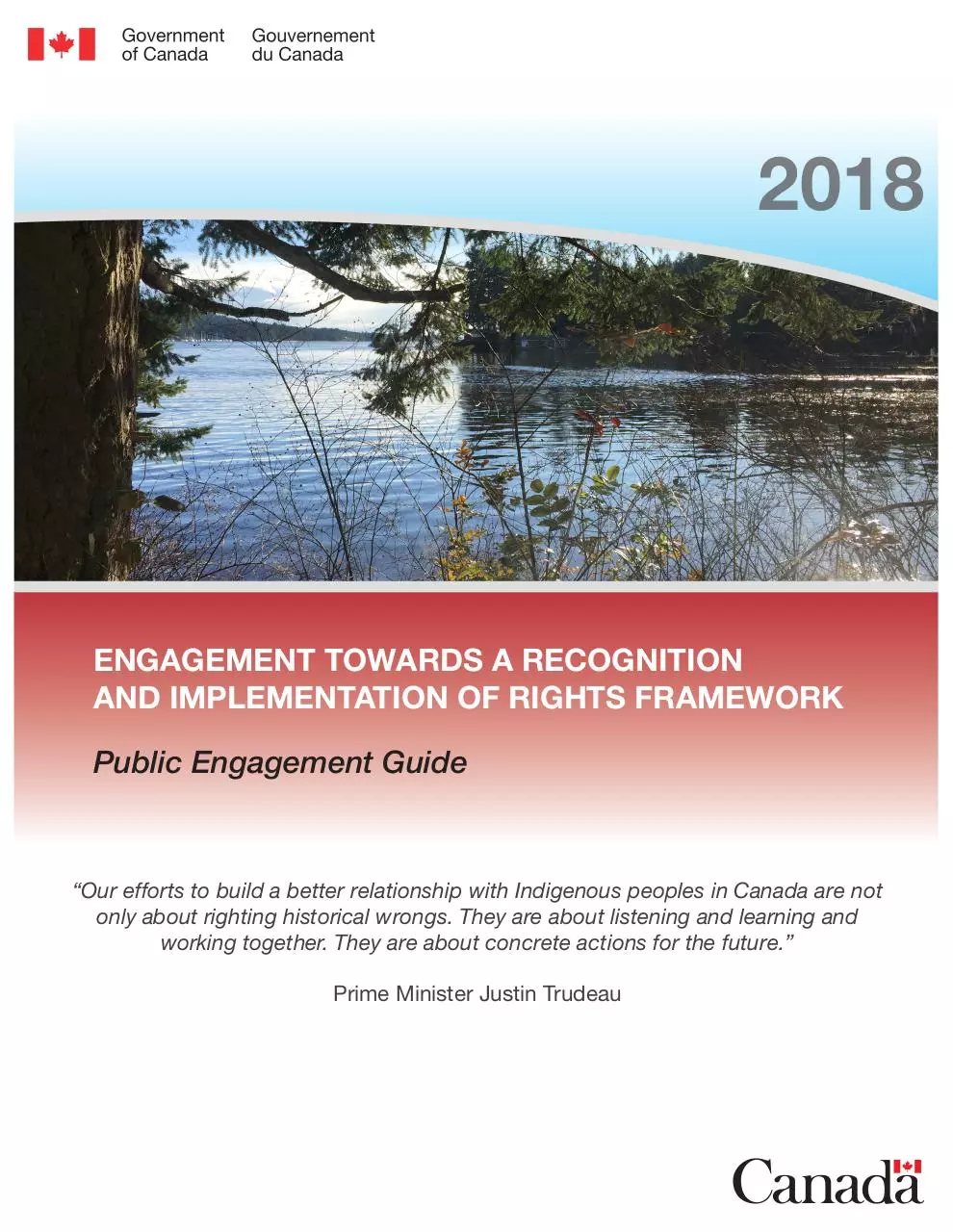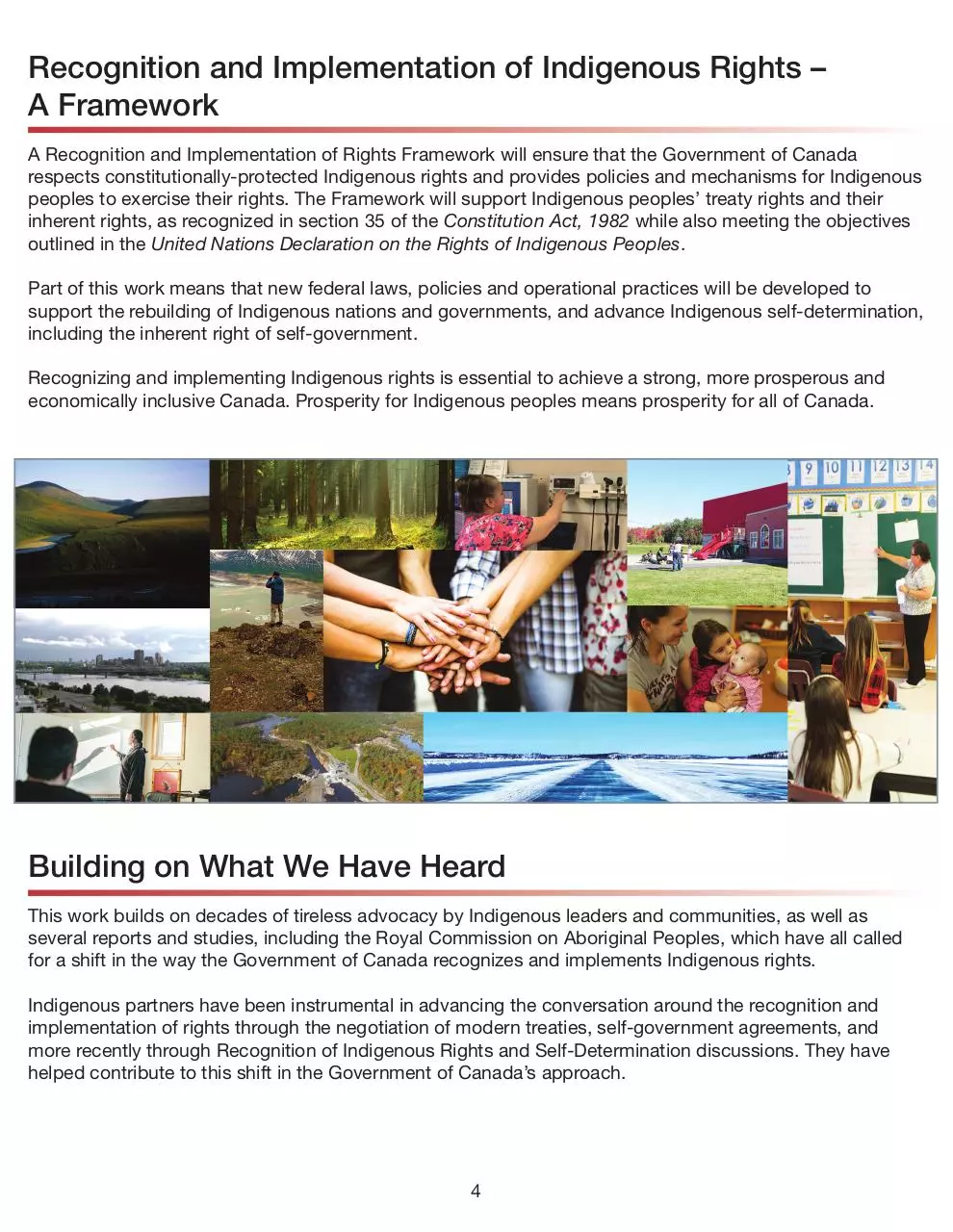Engagemen Discussion Guide (PDF)
File information
This PDF 1.4 document has been generated by Adobe InDesign CS6 (Windows) / Adobe PDF Library 10.0.1, and has been sent on pdf-archive.com on 16/02/2018 at 18:01, from IP address 64.253.x.x.
The current document download page has been viewed 931 times.
File size: 3.32 MB (14 pages).
Privacy: public file





File preview
2018
ENGAGEMENT TOWARDS A RECOGNITION
AND IMPLEMENTATION OF RIGHTS FRAMEWORK
Public Engagement Guide
“Our efforts to build a better relationship with Indigenous peoples in Canada are not
only about righting historical wrongs. They are about listening and learning and
working together. They are about concrete actions for the future.”
Prime Minister Justin Trudeau
Tell Us What You Think
Note to reader: This document may be updated throughout
the engagement to respond to what we are hearing.
For information regarding reproduction rights, please contact:
aadnc.communicationspublications.aandc@canada.ca
www.canada.ca/indigenous-northern-affairs
1-800-567-9604
TTY only 1-866-553-0554
QS-6390-000-EE-A1
Catalogue: R5-686/2018E
ISBN: 978-0-660-25055-7
© Her Majesty the Queen in Right of Canada, 2018. This publication is also available in French under
the title: Mobilisation visant un cadre pour la reconnaissance et la mise en oeuvre des droits.
PURPOSE
The Government of Canada is committed to renewing the relationship with First Nations, Inuit and Métis
peoples based on the recognition of rights, respect, cooperation and partnership. To live up to this
commitment, the Government of Canada is undertaking major reforms to its laws and policies to ensure
the constitutional commitments made to Indigenous peoples are respected. The recognition and
implementation of Indigenous rights is central to Canada’s relationship with First Nation, Inuit and Métis
peoples and to advance the vital work of reconciliation. We also know Indigenous communities that have
control over the decisions affecting their communities have better socio-economic outcomes.
As part of the ongoing journey of reconciliation, the Government of Canada has launched a national
engagement to help develop a Recognition and Implementation of Rights Framework.
WHAT DOES A RECOGNITION OF RIGHTS APPROACH MEAN?
All Canadians have rights and freedoms. The Constitution Act, 1982, including the Charter of Rights
and Freedoms, outlines these rights. Indigenous rights are also recognized and affirmed in section 35 of
the Constitutional Act, 1982. These refer to the collective rights held by Indigenous peoples under our
Constitution.
First Nation, Inuit and Métis peoples are descendants of the first people who lived in what is now known
as Canada. They have unique rights that are recognized and protected by the Constitution, but laws and
policies are needed to support the exercise of those rights. The Government of Canada is working with
First Nation, Inuit and Métis peoples to create the federal laws and policies needed to fully and clearly put
those rights into practice.
The goal is to chart a new way forward for the Government of Canada to work with First Nations, Inuit and
Métis peoples, and to end decades of mistrust, poverty, broken promises and injustices.
3
Recognition and Implementation of Indigenous Rights –
A Framework
A Recognition and Implementation of Rights Framework will ensure that the Government of Canada
respects constitutionally-protected Indigenous rights and provides policies and mechanisms for Indigenous
peoples to exercise their rights. The Framework will support Indigenous peoples’ treaty rights and their
inherent rights, as recognized in section 35 of the Constitution Act, 1982 while also meeting the objectives
outlined in the United Nations Declaration on the Rights of Indigenous Peoples.
Part of this work means that new federal laws, policies and operational practices will be developed to
support the rebuilding of Indigenous nations and governments, and advance Indigenous self-determination,
including the inherent right of self-government.
Recognizing and implementing Indigenous rights is essential to achieve a strong, more prosperous and
economically inclusive Canada. Prosperity for Indigenous peoples means prosperity for all of Canada.
Building on What We Have Heard
This work builds on decades of tireless advocacy by Indigenous leaders and communities, as well as
several reports and studies, including the Royal Commission on Aboriginal Peoples, which have all called
for a shift in the way the Government of Canada recognizes and implements Indigenous rights.
Indigenous partners have been instrumental in advancing the conversation around the recognition and
implementation of rights through the negotiation of modern treaties, self-government agreements, and
more recently through Recognition of Indigenous Rights and Self-Determination discussions. They have
helped contribute to this shift in the Government of Canada’s approach.
4
Focus of Engagement
Through the engagement process with First Nations, Inuit and Métis peoples, as well other partners and
key stakeholders, Canada expects to formalize the recognition and implementation of Indigenous rights
through new legislation and policies.
While specific components of this Framework will be based on the results of this engagement, legislative
and policy elements of the Framework may include:
Legislation to formalize the standard of recognition of Indigenous rights as the basis for all government
relations with Indigenous Peoples;
A new policy that reflects the unique needs of First Nations, Inuit and Métis peoples to replace the
current Comprehensive Land Claims Policy and the Inherent Right to Self-Government Policy;
Reforming government policies and practices to support the implementation of treaties and
self-government agreements;
Mechanisms to support the rebuilding of Indigenous nations and governments, and advance Indigenous
self-determination and the inherent right of self-government;
Creating new dispute resolution approaches to address rights related issues, including overlapping
territories and treaty implementation, that move us from conflict to collaboration;
Tools to strengthen a culture of federal government accountability and build greater trust between
Indigenous peoples and the federal government; and,
Legislation establishing the two new departments that will replace Indigenous and Northern Affairs
Canada with a mandate that better serves the distinct needs of First Nations, Inuit and Métis peoples.
KNOWLEDGE TO BUILD ON:
Report on the Royal Commission on Aboriginal Peoples,
1996
Truth and Reconciliation Commission Calls to Action, 2015
Multilateral Engagement Process to Improve and Expedite
Treaty Negotiations in British Columbia, 2016
The Lornie Report on Acceleration of BC Common Table
Treaty Negotiations, 2011
The work of the Working Group on the Review of Laws
and Policies Related to Indigenous Peoples, including the
Principles Respecting the Government’s Relationship with
Indigenous Peoples
Forging Partnerships, Building Relationships: Aboriginal
Canadians and Energy Development – Douglas Eyford,
2013
The work of the Senior Oversight Committee on
Comprehensive Claims, 2014
The work of the Office of the Treaty Commissioner in
Saskatchewan and the Treaty Relations Commission in
Manitoba
A New Direction: Advancing Aboriginal and Treaty Rights –
Douglas Eyford, 2015
Collaborative Fiscal Policy Development Process with
Self-Governing Groups
A Matter of National and Constitutional Import: Report of
the Minister’s Special Representative on Reconciliation
with the Métis: Section 35 Métis Rights and the Manitoba
Metis Federation Decision – Thomas Isaac, 2016
The work of the Permanent Bilateral Mechanisms
Over 50 Recognition of Indigenous Rights and
Self-Determination Discussion Tables
5
Working Together to Build a New Relationship
For too long, Indigenous peoples in Canada have had to prove their rights existed and fight to have them
recognized through costly court challenges. To truly renew the relationship between Indigenous peoples
and Canada, the Government of Canada needs a comprehensive and far-reaching approach, which
supports and empowers Indigenous communities as they shape their own future and find their own way
forward.
Part of this work means new federal laws, policies, and operational practices will be developed to support
the rebuilding of Indigenous nations and governments, and advance Indigenous self-determination,
including the inherent right of self-government.
Led by the Minister of Crown-Indigenous Relations and Northern Affairs, the Government of Canada is
engaging First Nations, Inuit and Métis peoples, as well as other partners and key stakeholders.
Engagement will centre on the legislative and policy changes necessary to reform government policies
and practices, to ensure the constitutional commitments made to Indigenous peoples are respected.
The Recognition and Implementation of Rights Framework will be introduced in 2018 and will form the
basis for all relations between Indigenous Peoples and the Government of Canada moving forward.
“Reconciliation calls upon us all to confront our past and commit to charting a
brighter more inclusive future. We must acknowledge that centuries of colonial
practices have denied the inherent rights of Indigenous peoples. At last, we must
work together with Indigenous peoples to design an approach in which inherent and
treaty rights can be recognized and Indigenous peoples can be supported in
implementing those rights. As we move towards the next 150 years of Canada,
I envision a country that is more inclusive of First Nations, Inuit and the Métis peoples.
Making this shift is fundamental to the growth and prosperity of Canada.”
The Honourable Carolyn Bennett, M.D., P.C., M.P.
Minister of Crown-Indigenous Relations and Northern Affairs
6
QUESTIONS FOR ENGAGEMENT
The Government of Canada is undertaking a major reform of its laws and policies to ensure the
constitutional commitments made to Indigenous peoples are respected. To achieve this, the government
is launching an engagement process with First Nations, Inuit and Métis peoples, as well as other partners
and key stakeholders, to develop a Recognition and Implementation of Rights Framework.
This engagement is an opportunity for us all to advance this work together. We look forward to
embarking on this historic journey and hearing your perspectives on how we can advance true and
meaningful change.
Engagement will take place through various means, including in-person meetings and by email at
Indigenous-Rights@canada.ca as well as through www.canada.ca/indigenous-rights. More information
about these opportunities to provide input is available at the end of this document.
Tell Us What You Think
Together, we need to explore practical ways to support Indigenous peoples to give effect to their
jurisdictions and laws, in order to determine their own political, economic and social structures.
Policy Reforms and New Laws
1. The Constitution Act, 1982 outlines the rights and freedoms of all Canadians. Canada also has laws,
policies, and practices through which these rights are recognized and implemented. What are the
legislative and policy changes that are necessary to reform government policies and practices in order
to ensure Indigenous rights are fully implemented?
2. How can the Government of Canada improve the implementation of historic treaties and resolve
historical grievances?
7
3. How can the Government of Canada improve the implementation of modern treaties and
self-government agreements?
4. What distinctions-based approaches could replace the current Comprehensive Land Claims Policy and
the Inherent Right to Self-Government Policy?
5. How would you define the role Provinces and Territories have in recognizing and implementing the
inherent and treaty rights of First Nations, Inuit, and Métis peoples?
8
Nation Building
The Royal Commission on Aboriginal Peoples (RCAP) defined an Indigenous nation as a sizeable
body of Indigenous people with a shared sense of national identity that constitutes the predominant
population in a certain territory or collection of territories – the report estimated the existence of
60 to 80 nations.
6. How would you define an Indigenous nation? If it differs from RCAP, how so?
7. Who should determine who is an Indigenous nation and who is not?
8. When it comes to First Nations, do modern treaty groups, traditional governments or retribalization
factor into defining nations?
9
Download Engagemen Discussion Guide
Engagemen Discussion Guide.pdf (PDF, 3.32 MB)
Download PDF
Share this file on social networks
Link to this page
Permanent link
Use the permanent link to the download page to share your document on Facebook, Twitter, LinkedIn, or directly with a contact by e-Mail, Messenger, Whatsapp, Line..
Short link
Use the short link to share your document on Twitter or by text message (SMS)
HTML Code
Copy the following HTML code to share your document on a Website or Blog
QR Code to this page

This file has been shared publicly by a user of PDF Archive.
Document ID: 0000735159.